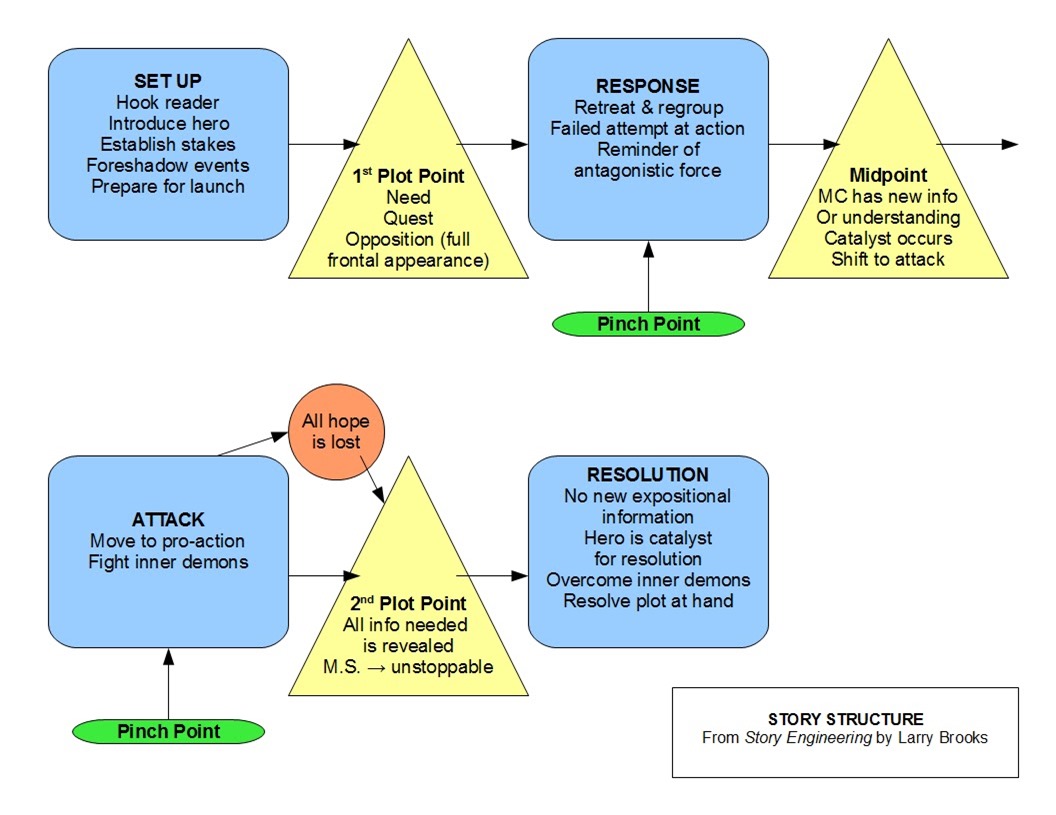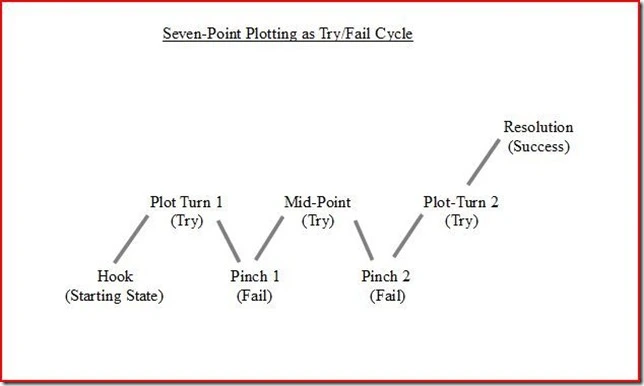In response to a question to me, I have not created a 7 Point Story Structure, but have shared many of them. Here’s an amalgamation of resource links. As we move into the big annual NaNoWriMo many of us may be looking for a quick method to plan out our new work.
I personally find that 7 main plot points is a good base for any novel structure, and one which will work with both story and main character arcs also, with character and story merging at these main points. Subplots and other character arcs can add more points.
7 Points can also be defined as a Classical Story Structure, and fits with the Hero’s Journey plot points as a “lite” version quite neatly also.
7 Point Story Structure
Image 1
1. Dan Wells
Horror writer Dan Wells is perhaps the King of the 7 Point Story Structure. His series of videos (five of them), openly available on Youtube, are a must-see because he explains the points so well, analysing Harry Potter, Pride & Prejudice and The Matrix alongside the points. From Well’s website, a powerpoint is also available and there is a series of blog posts on the framework also. (links below). Note that in the video presentations, Wells analyses the plot points through to character arcs with The Matrix as an example.
Many others have interpreted, explained and diagrammed Well’s structure.
Links:
- Dan Well’s 7 Point Story Structure Youtube series
- Powerpoint of the presentation content, shared from Well’s website.
- Blog posts on the framework –
Dan’s 7 Points are as follows –
 Hook – this is where the story begins, it’s what your characters start out as or the situation they’re in or the actions that are happening at that moment.
Hook – this is where the story begins, it’s what your characters start out as or the situation they’re in or the actions that are happening at that moment.
Plot Turn 1 – the part that forces the character or action to move forward.
Pinch 1 – where something serious happens that really puts pressure on the character to fall irrevocably into the arch of the story.
Midpoint – the point of no return, where the character makes that conscious decision to change or move forward on their own (this is where we transition from the Hook to the Resolution).
Pinch 2 – the point where the story really dips and something extreme happens (the mentor is lost, the friends disappear, the protagonist is left alone and in dire straights).
Plot Turn 2 – this is where the story reveals the tools or secrets needed to triumph (the climax of the arc).
Resolution – the story has concluded and we find ourselves in an opposite state from the initial Hook.
2. Belinda Crawford’s Pantser Beat Sheet
 Belinda Crawford has a few blog posts on using Dan Well’s 7 Point Story Structure, which she also put into a spreadsheet she called the Pantser’s Beat Sheet.
Belinda Crawford has a few blog posts on using Dan Well’s 7 Point Story Structure, which she also put into a spreadsheet she called the Pantser’s Beat Sheet.
On the below post, she talks about revising her own work against this sheet, she links to some posts, and she provides an Excel Spreadsheet with the 7 Points. The sheet is in two different versions – the first has the 7 Points, while V2 has the addition of a theme column.
Link: Belinda Crawford’s Pantser Beat Sheet (Excel)
3. Writers to Authors Seven Point Story Structure Ebook
If you subscribe to Jason Hall’s Writers to Authors email newsletter you are offered a download link which provides access to 5 different small ebooks or documents. One is the 7 Point Story Structure Quick Guide, a 5-page check-list explaining each point (via Dan Wells). Or you can read each step through the posts.
Link: Writers to Authors – How to Outline your Novel – Seven Point Story Structure.
4, Algis Budry’s (and others) and John Truby – 7 Point Plot Structures for Short Stories and more
Science Fiction writer Algis Budry is credited with a 7 Point Plot Structure, documented through Philip Brewer’s article ‘Story Structures in Short Stories’ (Speculations 45: 16–18 (Feb. 2002)), but also in Budry’s book called ‘Writing to the Point’. However there are several others with questions towards credits, discussed through short fiction terms and for speculative fiction. Here’s an article at SFF Chronicles which provides some of these. Or I like this interpretation better, found at SF Center. Budry’s are –
- a character,
- in a situation,
- with a problem,
- who tries repeatedly to solve his problem,
- but repeatedly fails, (usually making the problem worse),
- then, at the climax of the story, makes a final attempt (which might either succeed or fail, depending on the kind of story it is), after which
- the result is “validated” in a way that makes it clear that what we saw was, in fact, the final result.
Note that these points are very similar to that found in Image 4 below, available as a PDF by Novel Software. Budry also suggests that in longer fiction, the try-fail cycle should be repeated three times before hitting the climax. Image 7 below shows an amalgamation of Dan Well’s 7 points as try/fails.
Screenwriter John Truby also has a “Seven Basic Steps of Human Action” which can form points for plot. These are mentioned in the above article.
5. Larry Brooks
Larry Brooks also has a short story article – The Short Story on Structuring Your Short Story, in which he breaks down a 7 point story structure as –
“Like life, our stories always reside somewhere along that same continuum of set-up… shift… response… shift… attack… shift… resolution.”
Brooks, in his many writing craft books, talks about 7 Key Milestone Moments, documented in the below graph. Jami Gold shares several story arc beat sheets in excel format, including one for Larry Brook’s Story Engineering structure. Julie Glover also put the structure into a more colourful chart below.
Image 8
5. Others
Image 3
- Dramatica has a PDF with several plot structure diagrams and explanations, as a comparison with their own. Interestingly, they provide Screenwriter Syd Field’s structure diagram as a 7 Point Plot. [Image 3]
- Novel Software has another interesting interpretation, which can be seen as a way of using the 7 Points as useful as an elevator-pitch type summary of the entire story. This can be downloaded as a PDF from the link above. [Image 4]. This image is very similar to the 7 Point Story Structure credited to Algis Budry (see above).
- E.P. at Green Where U Water It, has a condensed powerpoint and mindmap summary of Dan Well’s 7 Points here. You can pick up the mindmap as a PDF. [Image 5]
- Daphne at The Self Publishing Toolkit also runs down Dan Well’s points, and includes a simple table template and Scrivener template to download. The post also contains all five of Well’s videos.
- If you use the Mindmeister mindmapping software, there’s a 7 Point mindmap template here
- Karen Woodward has a 2013 post series on Dan Well’s story structure.
- The Lite version of the Hero’s Journey takes Joseph Campbell’s story structure down from 19 (13 or 10, depending on what versions you use) points to 7. See Image 6 below.
- Finally, Janet Fox and several others have created graphs comparing many different plot structures or paradigms. Janet’s is below, but also available in PDF form from her website. [Image 9]
Image 4
Image 5
Image 6
Image 7
Image 9
Credits:
- Image 1 by The Thoughtful Novelist (also feature image)
- Image 2 (Dan Wells plot points) – unknown (found on Pinterest)
- Image 3 (Syd Field’s Paradigm – diagram by Dramatica within PDF comparison here)
- Image 4 (Elevator sentences) – diagram by Novel Software.
- Image 5 by Green Where U Water It – mindmap available as PDF here
- Image 6 – Lite version of Hero’s Jouney – credit unknown.
- Image 7 – Try/Fail diagram – Caleb
- Image 8 – Julie Glover’s flowchart of Larry Brook’s Story Engineering structure, from here.
- Image 9 – Janet Fox’s comparison of paradigms, also available in PDF form from her website.











Hi!
I subscribed to your blog a while ago and am rather enjoying it. I wondered if you’d like to look at mine. I’m a 62 year old artist and writer and renaissance soul and I’ve recovered from depression and anxiety after 30 years. I’m now making up for lost time. I think I’m doing ok…
Jo UK http://www.joclutton.simplesite.com
Reblogged this on BRIDGET WHELAN writer and commented:
This post is a treasure chest of resources, dealing with the hardest problem of all: how to transform the idea in your head into a compelling story.I’ve been following this Australian blog for years and am all the better for it. The blogger Hunter Emkay is a powerhouse of information on anything relating to writing. I recommend reading it and following.
Thank you – yet again – for your hard work. I’ve reblogged it and also posted it on my facebook creative writing page https://www.facebook.com/creativewritingschool/ (which I don’t usually do as I like to publish different material on the two sites, but I felt this was too good to miss). I’ve also added stern recommendations to read the rest of your blog and follow!
So much to take in here. Many thanks for all the hard work So generously shared!
Reblogged this on Wendy Unsworth and commented:
Such a wealth of information here. As I work through the 1st draft of my WIP I will be referring back to this again and again. Thank you to blogger, Hunter Emkay for such a powerful resource.
Reblogged this on Chris The Story Reading Ape's Blog.
Not only did I like this, I also bookmarked it on my google chrome. I totally (accidentally) followed this on my first book. Will pay closer attention on my next projects!
Thanks so much for sharing this informative post. Great for all writers.
Cool, this should be a great help in structuring my own stories – when I eventually get round to writing them! Reblogging on Elemental Quill.
Reblogged this on Elemental Quill and commented:
Need a guide for story structure?
Thanks so much for sharing this. I’m going to explore all the links you provided.
I am indeed going to take part in NaNoWriMo and the project I’d like to work on is at such a early stage that I’m welcoming any tools that may help me define a structure. I know I can pant any skinny structure, but I’m a planner enough that I need at least that structure, or I’m going to get stuck. Doesn’t matter if I’ll probably won’t follow it, I just need it to be there 🙂
Thanks again. Great post!